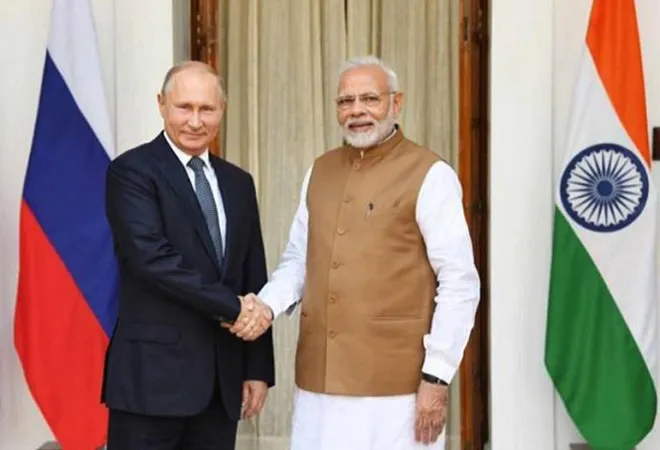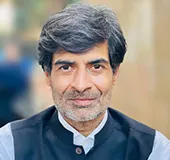
The narrative of a widening strategic gap between New Delhi and Moscow has been prevalent for some time now. Even within the strategic communities of Russia and India, there is an ongoing assessment of the importance of this bilateral engagement. Ahead of the upcoming India-Russia summit, this article delves into what is working for the relationship between the two nations, and what needs to be worked on.
It would be fair to say that the essential glue keeping the two together is strategic legacy. It is supplemented by a contemporary strand of political convergence in a world where both South Block and the Kremlin are actors, but also being acted upon.
One of India’s primary objectives in the coming decades is to prevent China’s hegemony in Asia. A multipolar world and a multipolar Asia are in its interest. Russia will strongly endorse this, and, for differing reasons, seek it. In its calculus, it would position the US as the principal protagonist to thwart. The Russians would not want to curtail China if that ends up enabling US influence. Therefore, there is a big picture convergence on a multipolar world order, even as India and Russia differ on relative roles of the poles shaping this order.
As of 2020, Russian weapons systems and equipment accounted for about 60 per cent of the inventory of the Indian armed forces.
This could change dramatically if Russia were to reach the conclusion that it is happy to sit in the court of the Emperor in Beijing as a junior partner. India sees this as unlikely. It hopes for a more independent Russian worldview that would not hesitate to differ with others, including China, in defence of its own interests. New Delhi is, therefore, continuing to invest substantially in this relationship, and in a number of areas.
The first and biggest is defence. As of 2020, Russian weapons systems and equipment accounted for about 60 per cent of the inventory of the Indian armed forces. While India is determinedly diversifying sourcing of military hardware, Russia remains a strong legacy player. Much of this is driven by spares and component upgrades. However, there have also been significant new ventures. These include the S-400 missile contract (on track for first deliveries this year); manufacture and co-production of four Project 1135.6 Frigates; manufacture of the world’s most advanced assault rifle – the AK-203 – under the ‘Make in India’ initiative; and additional deliveries of T-90s, Sukhoi-30 MKI, MiG-29, MANGO ammunition and VSHORAD systems. Russia is more involved with the ‘Make in India’ initiative in defence equipment than any other country.
Simultaneously, exercises have also increased in numbers and sophistication. As he demitted office as Indian Ambassador in Russia, DB Venkatesh Varma pointed out that the two nations were exploring different formats – including mobilisation of forces and their transportation across long distances, impact of drone technology on modern warfare, and impact of cyber on future of conflict. The landscape for doctrinal coordination and understanding is ever expanding.
India aims to increase import of oil from Russia, currently 1 per cent of all imports, to 4 or 5 per cent in the next five years.
The second area of convergence is energy. This includes not only hydrocarbons (oil and gas), but also nuclear. While India does import gas from Russia, a rapid increase is on the cards. If successful, the Vostok negotiations will bring India into one of the world’s biggest energy projects. India aims to increase import of oil from Russia, currently 1 per cent of all imports, to 4 or 5 per cent in the next five years. Another avenue is petrochemicals, where a Russian investment in the Paradip cracker plant and an Indian investment in Arctic LNG-2 are being explored.
With India announcing its net zero target date, the need to transition to greener energy sources has become imperative. A new Gas Task Force will bring in Russia as a major partner, including in the field of hydrogen.
The third area of mutual interest is high-technology. A proposal to establish a Joint Commission on Science and Technology Cooperation is being explored. It would encompass hi-tech areas like quantum, nanotechnology, cyber, AI, robotics, space and bio-technology. Pharmaceuticals, digital finance, chemicals and ceramics are all potential economic drivers of the relationship. Each of these is at the core of the fourth industrial revolution.
The fourth area of significance is food security. India leasing land in the Russian Far East, and cultivating it with Indian labour, offers a tantalising prospect. Russia is going through a demographic crisis and has notable human resources deficits. China has leased thousands of hectares of land in the Russian Far East. This is cultivated by Chinese farmers, whose produce is partially sold in the Russian domestic market and partially exported to China.
A proposal to establish a Joint Commission on Science and Technology Cooperation is being explored. It would encompass hi-tech areas like quantum, nanotechnology, cyber, AI, robotics, space and bio-technology.
A similar strategy can be followed by India. The government could negotiate an enabling arrangement with Russia but leave it to the private sector to execute. The Chennai-Vladivostok maritime connectivity corridor enhances scope for such cooperation.
This strategy would be a genuine win-win. India would contribute to its food security by reducing load on its resources (land, water, electricity) and providing opportunities to its excess farm labour. For Russia, dependency on China would come down, giving Moscow the strategic leverage that it needs and wants.
And here is where India needs to answer a strategic question. Is it willing to invest in the Russia story just as we celebrate Russia’s engagement with “Make in India”? India must write itself into the development text of the Far East and other parts of Russia through investments and expertise. There could be no stronger foundation for the relationship.
There is also an urgent need to overcome some recent angularities. The first is Afghanistan. At least till 15 August 2021, India and Russia had a serious disagreement, with Moscow unabashedly flirting with the Taliban. While both countries want stability in Afghanistan and curbs on export of terrorism and drugs, the perception in New Delhi is Moscow’s negotiators with the Taliban ended up become negotiators for the Taliban. That is a credibility problem for Russia to ponder.
India must write itself into the development text of the Far East and other parts of Russia through investments and expertise.
The second divergence is on the Indo-Pacific. It boils down to lack of trust. Russia does not trust India vis-à-vis the US, and India hears Russia reading from China’s script. This is a challenge to be addressed. Either country is the other’s flexibility mechanism, an arrangement that has stood the test of time. Russia’s ‘Greater Eurasia’ project and the Indo-Pacific are complementary and describe the same emergence: Of a new political moment and of a political geography that will seek a new alignment of interests and actors. Even as India and Russia carve new relationships, their sturdy partnership is a bank guarantee for both.
President Vladimir Putin’s visit to India is only his second trip abroad since the beginning of the pandemic. The first was to Geneva earlier this summer, for a summit with President Joe Biden. Coming to New Delhi to meet Prime Minister Narendra Modi is hugely symbolic and strategic. It indicates that the President knows India allows him a more equal partnership with China, even as Russia offers India room for its own endeavours.
This article was first published in the Economic Times’ magazine
The views expressed above belong to the author(s). ORF research and analyses now available on Telegram! Click here to access our curated content — blogs, longforms and interviews.




 PREV
PREV


